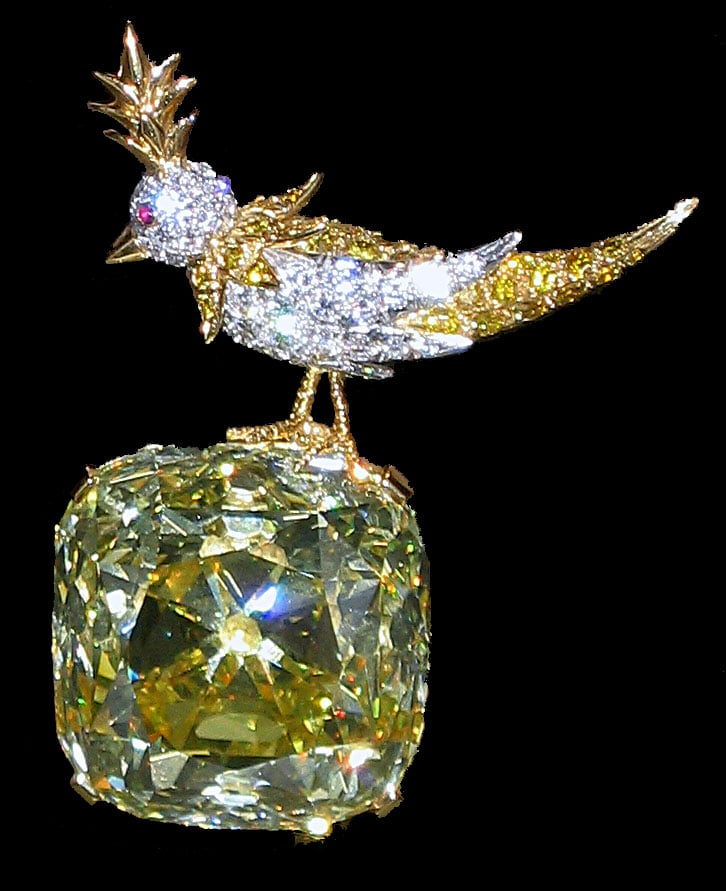The Tiffany Yellow Diamond is the largest yellow diamond ever discovered. The diamond weighted 287.42 carats in rough when discovered in the Kimberley Mine in 1878. One year later, the diamond was cut into a cushion shape of 128.54 carats with 82 facets. That was 24 more than a traditional round diamond, which in end maximized the brilliance of the diamond. The Tiffany Yellow is on display at the flagship store on Fifth Avenue in Manhattan. Only two women have ever worn the diamond, one of which is Audrey Hepburn in the 1961 movie Breakfast at Tiffany’s. The other woman is Mrs. Sheldon Whitehouse at the 1957 Tiffany Ball in Newport, Rhode Island.
When was it discovered?
The Tiffany Yellow was discovered in South Africa in 1877 in the Kimberley Mine. The stone was purchased by Charles Tiffany, the founder of Tiffany & Co. He purchased the diamond for $18,000. The company hired a gemologist, George Frederick Kunz to study the gem and cut it. As mentioned previously, the gem weighted 287 carats in rough. Kunz, who was 23 years old at the time, studied the gem for one year before he started to cut it. He managed to reduce the diamond from 287 carats to the current size of 128 carats.
Kunz just joined the company, and he decided to add additional 32 facets to the square antique brilliant cut. That brought the total facets up to ninety, increasing the brilliance of the diamonds. Larger diamonds with comparable brilliance were not fashioned until deep into the 20th century.
Tiffany’s Rise to Popularity
Some might say that Breakfast at Tiffany’s was responsible for the company’s rise to popularity. But the movie came out in 1961, and the company was famous in New York long before 1958. That was the year the book came out, and the movie followed three years later.
Tiffany was founded by Charles Lewis Tiffany in 1837. The company took advantage of the political disturbance in Paris in 1848 which resulted wit hthe overthrough of King Louis Philippe. At the time, the company bought a large quantity of jewels. In 1887, the company bought a great diamond necklace of Empress Eugenie, the finest single item to go on sale at the time.
The company also profited from the discovery of diamonds in South Africa. Tiffany & Co was very active in South Africa, buying several diamonds weighting more than 50 carats and cutting them in New York City. But their biggest prize was the Tiffany Yellow, named after the company and discovered before accurate records of discovery of large diamonds from South Africa were kept.
In 1879, the company bought the Tiffany Yellow for $18,000. The diamond was imported into the United States with little publicity. The policy was set by Charles Tiffany, who had fears that the diamond might be a “yellowish” diamond produced in South Africa. There is a big distinction between light yellow, yellowish, and the rare deep canary yellow diamonds. The Tiffany Yellow is the finest example of all three.
The gem became widely known in 1896, when Viceroy Li Hung-Chang, one of the triumvirates who ruled China visited America. He announced that one of the reasons he is visiting America is to see the Tiffany Yellow diamond.
Specific Gem Cut
No major gemological organization has ever formerly examined the diamond. Or at least, we do not know of any findings ever made public. What makes the Tiffany Yellow unique is the cut. The diamond does not have typical Stellar Cut Brilliant cut. The crown is stepped, and that involves splitting the main facets.
The pavilion of the diamond received three steps, a third one applied between the regular two. This makes the diamond unique. How was that executed? The jeweler split the lower main facets into two triangular and one flat keystone-shaped facet. That way, the diamond received 40 facets on the crown, and 48 more on the pavilion. The standard Brilliant Cut had just 56 plus two facets. The Tiffany Yellow, had 90.
No one ever explained why such a bulky step cut was applied to the Tiffany Yellow. One explanation, by Dr. Kunz is that the stone was of yellow color, and the cut would give smothered, smoldering fire of flashing radiance to the diamond.



